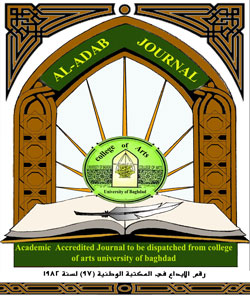A Comparative Study of the Development Process between Ancient Chinese and Arabic Literature
DOI:
https://doi.org/10.31973/aj.v0i134.745Keywords:
Ancient Chinese Literature, Ancient Arabic Literature, Comparative Literature, Literature CharacteristicsAbstract
Both China and the Arab World are famous for their ancient literature history. Accordingly, a large number of ancient proses and poems appeared in both two regions in the earlier time. Then, those kinds of literary arts developed through different ages, just as the criticism, rhetoric and other knowledge concerned with the literature did, and there’re many similarities as well as differences between the developmental process of ancient Chinese literature and the ancient Arab literature. In the tide of globalization, the earth has become much smaller thanks to the development of technology. Thus, more and more Chinese people desire to know about the Arab world, just as the Arab people want to know about China, so the contacts between them have been intensified, such as the exchanges in the field of ancient literature. To enhance the study of the ancient Arabic and Chinese literature, we need to pay more attention to their developmental track including their origins, developmental stages, achievements, and representatives, etc. This modest paper aims to study the above topics based on the documentary method. It will also resort to the descriptive-analytical approach and the comparative approach to solve the related problems.
Downloads
References
A Comparative Study of the Development Process between Ancient Chinese and Arabic Literature
Daif, Shawky (1973). History of Arabic Literature: Islamic Era. 1st Ed. Dar Al-Maaref, Cairo, Egypt.
Dhaif, Shawky (1960). History of Arabic Literature: Pre-Islamic Era. 1st Ed. Dar Al-Maarif, Cairo, Egypt.
Dhaif, Shawky (1973). History of Arabic Literature: the Second Half of the Abbasid Era. 1st Ed. Dar Al-Maarif, Cairo, Egypt.
Guo, Jie et al. (1998). Stories of Chinese Literature History. 1st Ed. Part 1. People’s Press of Ji Lin, Chuang Chun, Ji Lin.
Guo, Jie et al. (1998). Stories of Chinese Literature History. 1st Ed. Part 2. People’s Press of Ji Lin, Chuang Chun, Ji Lin.
Li, Xiaolong et al. (2004). History of Chinese Literature. 1st Ed. Part 1. Literature and History Press, Beijing, China.
Makki, Ahmed. (1999). Study of Literature Sources. 2nd Ed. Arab Thought Press, Cairo, Egypt.
Mandour, Muhammad. (2012). Literature and Its Arts. 1st Ed. Egyptian Renaissance Press for Printing, Publishing and Distribution, Cairo, Egypt.
Salim, Mahmoud Rizk (1957). Arabic literature and Its history in the Era of the Mamluks, the Ottomans, and the Modern Era. 1st Ed. Egyptian Modern Press Group, Cairo, Egypt.
Yuan, Xingpei (2003). History of Chinese Literature. 1st Ed. Part 2. Literature and History Press, Beijing, China.
Yuan, Xingpei (2003). History of Chinese Literature. 1st Ed. Part 3. Literature and History Press, Beijing, China.
Yuan, Xingpei (2003). History of Chinese Literature. 1st Ed. Part 3. Higher Education Press, Beijing, China.
Zhong, Jikun (2010). History of Arabic Literature. 1st Ed. Yilin Publishing House, Nan Jing, China.
Downloads
Published
Issue
Section
License
Copyright and Licensing:
For all articles published in Al-Adab journal, copyright is retained by the authors. Articles are licensed under an open access Creative Commons CC BY 4.0 license, meaning that anyone may download and read the paper for free. In addition, the article may be reused and quoted provided that the original published version is cited. These conditions allow for maximum use and exposure of the work.
Reproducing Published Material from other Publishers: It is absolutely essential that authors obtain permission to reproduce any published material (figures, schemes, tables or any extract of a text) which does not fall into the public domain, or for which they do not hold the copyright. Permission should be requested by the authors from the copyrightholder (usually the Publisher, please refer to the imprint of the individual publications to identify the copyrightholder).
Permission is required for: Your own works published by other Publishers and for which you did not retain copyright.
Substantial extracts from anyones' works or a series of works.
Use of Tables, Graphs, Charts, Schemes and Artworks if they are unaltered or slightly modified.
Photographs for which you do not hold copyright.
Permission is not required for: Reconstruction of your own table with data already published elsewhere. Please notice that in this case you must cite the source of the data in the form of either "Data from..." or "Adapted from...".
Reasonably short quotes are considered fair use and therefore do not require permission.
Graphs, Charts, Schemes and Artworks that are completely redrawn by the authors and significantly changed beyond recognition do not require permission.
Obtaining Permission
In order to avoid unnecessary delays in the publication process, you should start obtaining permissions as early as possible. If in any doubt about the copyright, apply for permission. Al-Adab Journal cannot publish material from other publications without permission.
The copyright holder may give you instructions on the form of acknowledgement to be followed; otherwise follow the style: "Reproduced with permission from [author], [book/journal title]; published by [publisher], [year].' at the end of the caption of the Table, Figure or Scheme.












